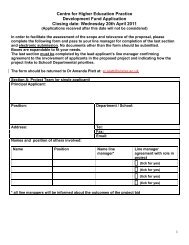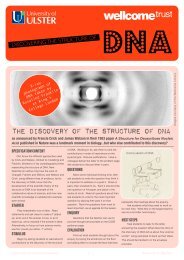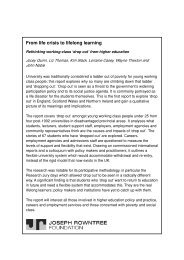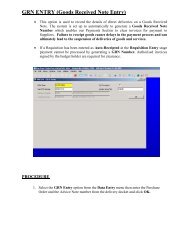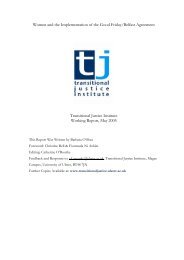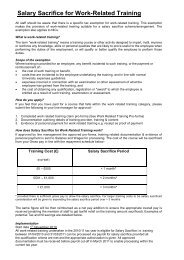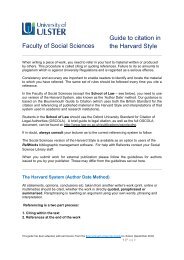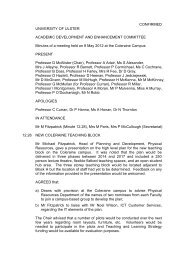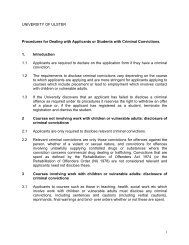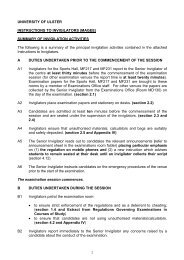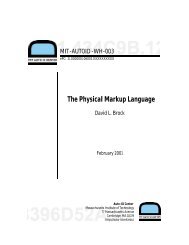E Determining Avogadro's Number
E Determining Avogadro's Number
E Determining Avogadro's Number
You also want an ePaper? Increase the reach of your titles
YUMPU automatically turns print PDFs into web optimized ePapers that Google loves.
E<br />
Mole Day Planning Pack<br />
<strong>Determining</strong> Avogadro’s<br />
<strong>Number</strong> using Electrolysis<br />
This experimental set up provides you with all the information you need to determine<br />
Avogadro’s number. If you need any help, use the hint cards. These are structured to help you<br />
understand how you get from your measurements to the answer. Remember to wear safety<br />
glasses throughout the experiment.<br />
Clean and dry a pair of copper electrodes.<br />
wires<br />
copper<br />
sulphate<br />
solution<br />
Find the dry mass of the anode before you start the experiment.<br />
Set up the apparatus below. Use 0.1 M CuSO4 (aq) (harmful) as the electrolyte. You will also<br />
need a stopwatch.<br />
Switch the power supply on, starting the stopwatch at the same time. Record the current<br />
(about 0.4 A, but record the exact current you read off the ammeter) and leave for about 35<br />
minutes.<br />
Find the mass of the anode when dry at the end of the experiment.<br />
While you are waiting, write down the steps you are going to take to calculate Avogadro’s<br />
number.<br />
Calculate Avogadro’s number using your experimental data. Compare your value with the<br />
value 6.02 x 10 23 . Identify sources of error.<br />
Information<br />
Remember to complete a risk assessment<br />
before beginning practical work.<br />
A<br />
power supply<br />
beaker<br />
carbon electrodes<br />
e charge on 1 electron / C<br />
n chemical amount / mole<br />
Oxidation of copper at anode:<br />
Cu (s) Cu ÷<br />
÷<br />
÷<br />
2+ (aq) + 2e- N number of atoms NA = nCu NCu<br />
NA Avogadro’s number Molar mass of Copper = 63.55 g mol-1 Q charge / C e = 1.60 x 10-19 I current / A<br />
Q = It<br />
C<br />
<strong>Number</strong> of electrons = Q e<br />
n = mass/g molar mass/ g mol-1 n = No. elementary entities NA<br />
Extension activity: The faraday, F, is defined as the amount of electrical charge on one mole of<br />
electrons. What value does your experiment give you for the Faraday? Compare it with the<br />
literature value 96500 C mol-1 ÷<br />
(3 SF).<br />
www.ulster.ac.uk/scienceinsociety/ 13<br />
ANALYSING PROBLEM SOLVING<br />
S
Mole Day Planning Pack<br />
<strong>Determining</strong> Avogadro’s <strong>Number</strong> using Electrolysis<br />
Hint cards<br />
Cut one set of cards out for each table. Fold along the dotted line and place the cards face<br />
down (number facing up) on the table. Students can refer to the hint cards if they have<br />
problems in deciding their strategy for answering the question.<br />
1<br />
Avogadro’s number<br />
2<br />
Amount of copper<br />
(in moles)<br />
3<br />
<strong>Number</strong> of atoms of<br />
copper<br />
4<br />
<strong>Number</strong> of electrons<br />
(a)<br />
5<br />
<strong>Number</strong> of electrons<br />
(b)<br />
Avogadro’s number<br />
You can calculate Avogadro’s number from the equation:<br />
÷<br />
NA = nCu NCu<br />
You will need to find the number of moles of copper (see card 2) that<br />
take part in this reaction and the number of atoms of copper (see card<br />
3) that take part in this reaction.<br />
Amount of copper (in moles)<br />
To find the number of moles of copper that took part in electrolysis<br />
you can use the equation<br />
÷<br />
n = mass/g molar mass/ g mol -1<br />
The mass of copper will come from your experiment.<br />
Mass of copper that took part in electrolysis = Mass of anode at start<br />
– mass of anode at end<br />
<strong>Number</strong> of atoms of copper<br />
Look at the equation for oxidation at the anode in the information<br />
box. This links the number of atoms of copper with the number of<br />
electrons that take part in electrolysis.<br />
What is the ratio of electrons to copper atoms?<br />
If you are stuck on how to find out the number of electrons that take<br />
part in electrolysis, see card 4.<br />
<strong>Number</strong> of electrons (a)<br />
Electric current consists of electrons carrying charge through a wire.<br />
To calculate the total charge that is passed through the wire, you will<br />
need to use the equation linking current, charge and time.<br />
Substitute your values from your experiment. To find out how to<br />
convert from charge to number of electrons see card 5.<br />
<strong>Number</strong> of electrons (b)<br />
The information table tells you the charge of one electron. You have<br />
just calculated the total charge.<br />
Now calculate how many electrons took part in electrolysis using the<br />
relationship:<br />
Total charge = <strong>Number</strong> of electrons x Charge of one electron<br />
www.ulster.ac.uk/scienceinsociety/ 14<br />
ANALYSING PROBLEM SOLVING<br />
T



